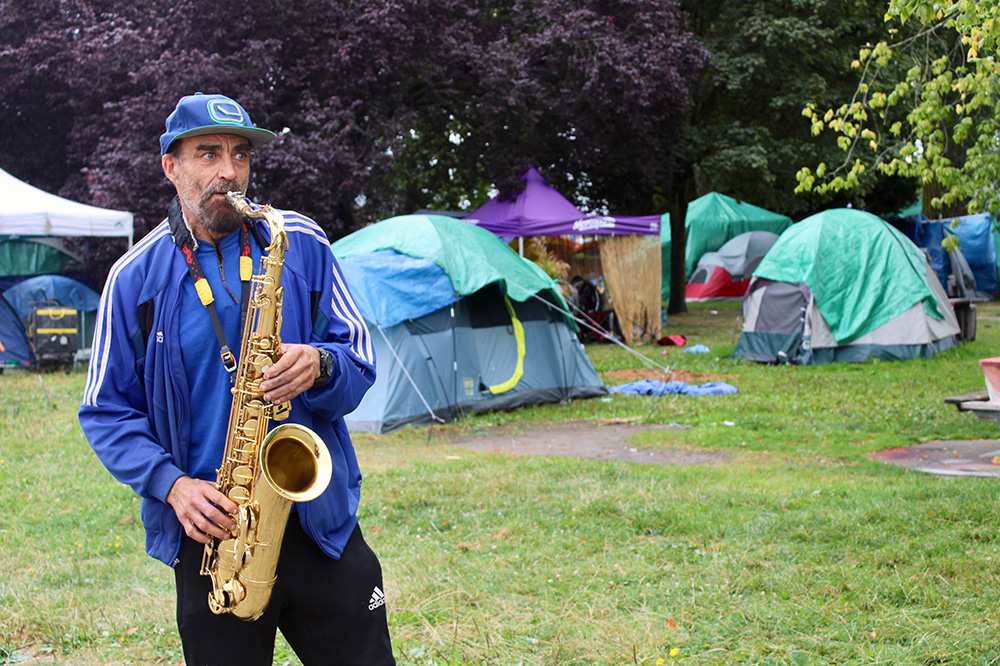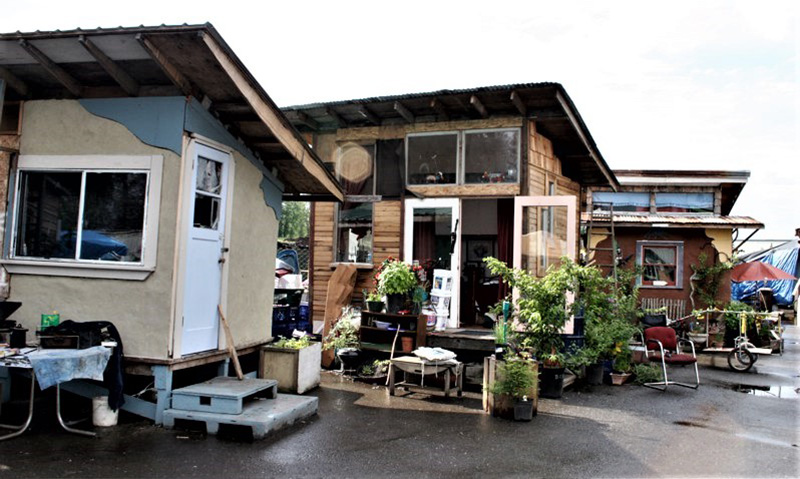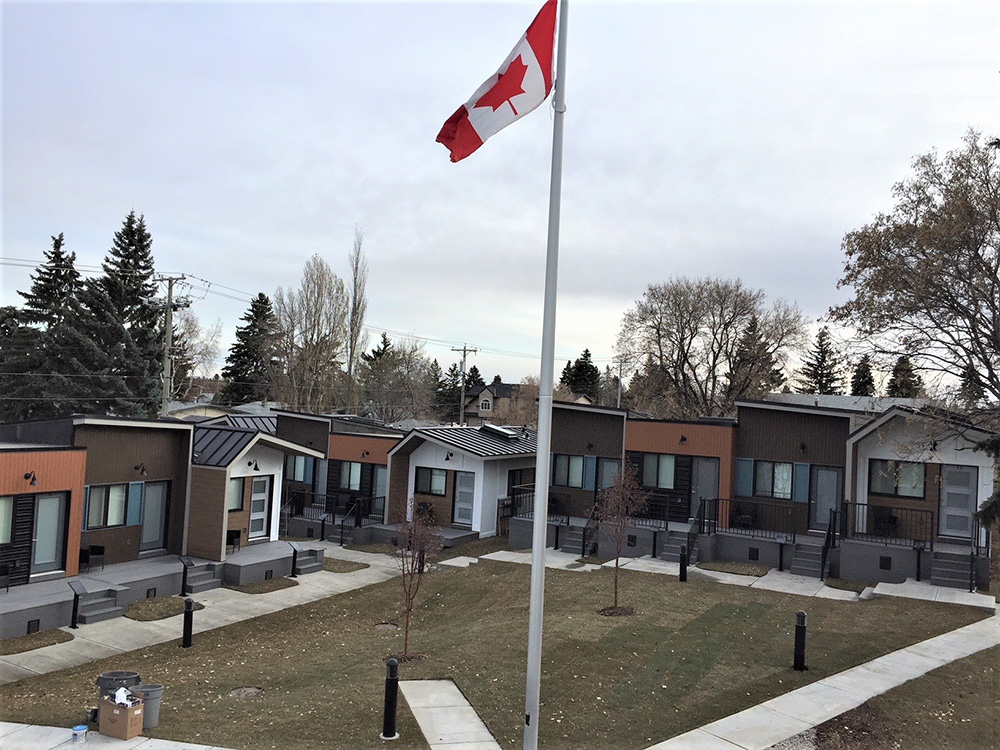Tent city residents and organizers say they’re interested in the possibility of replacing tents with tiny homes, but В鶹ҙ«ГҪУі»ӯcity staff say the idea is not an option as Strathcona Park continues to host what’s estimated to be Canada’s largest tent city.
For the past two weeks, The Tyee has been exploring tiny homes as a potential solution to homelessness in Vancouver. UBC urban planning professor Patrick Condon and The Tyee on their success in Seattle. There, a dozen such communities are slated to grow to 40. “For very little cost we are setting up villages that are housing hundreds of people,” said Sharon Lee of Seattle’s Low Income Housing Institute, who called tiny homes “a bridge to permanent housing.”
Tiny home communities are common in the United States and are now being created in some Canadian cities.
Darrell Zimmerman has lived at the Strathcona Park tent city for two months, a welcome respite from his insect and rodent-infested single-room occupancy hotel room in Chinatown. He likes the idea of living in a tiny home.
“You have the pride of ownership, the pride of having your own space,” Zimmerman said. “In [SROs] it’s very transient. The landlords are bullies: ‘Hey you’d better follow this rule, you can’t have a visitor after 11 p.m.’”
Trying to abide by all those rules can be difficult for people with mental illness, Zimmerman said.
Fiona York, a community organizer who has been supporting the Strathcona Park tent city, says a tiny home village could be a potential solution, but it would have to be run by residents, not a social service agency, to provide a viable alternative.
“People don’t want to go into that structure where it’s all managed, like show ID when you come in,” York said, referring to a common rule at supportive housing buildings requiring guests to show ID.
But tiny homes would help with sheltering people from the cold and Vancouver’s persistent winter rains, and would reduce the constant threat of fire, York said. When it gets cold, tent city residents turn to heat sources that are often fuelled by propane, and that can prompt orders from the fire department.
They would also be more secure, giving residents the ability to lock a door instead of constantly being worried their tents will be cut open and stolen from.
York envisions tiny home communities spread out across the city, tailored to the specific needs of certain groups: people who are sober or are in recovery could live in one group perhaps, while another community could be low-barrier and offer harm reduction services for drug use.
“I’d say it’s not so much the physical structures, but it’s more about how it’s done,” York said.
В鶹ҙ«ГҪУі»ӯhas continuously had a tent city in one location or another since 2016. The idea of formalizing one or more sites for legal camping, or adding small structures, is a no-go for the city. The city’s current plan involves attempts to house people in supportive housing buildings or shelters. It’s an approach that has so far failed to eliminate large encampments of unhoused people.
“Our staff look to other cities around the world for innovative approaches to a wide variety of municipal issues, but we must also factor in local limitations,” communications staffer Ellie Lambert wrote to The Tyee in an email.
“For example, if we were to explore the option of tiny homes we would be impacted by the lack of large, affordable development sites that are available and we would also need to consider whether the tiny homes meet our land use and building bylaws.”
Other cities have shown tiny home enclaves can be tucked into areas as small as a 10-car parking lot. Lambert insists, “Sites that would be appropriate for tiny homes have been prioritized for temporary modular housing which provide larger self-contained units and can be multiple storeys high, therefore more homes can be created on each site.”
Asked to explain what regulations prevent considering tiny homes for the homeless in Vancouver, Lambert admitted “city bylaws and building codes do allow for many small home typologies city-wide or in certain zones, including laneways, lock-off suites in condos/duplex/townhomes, basement suites, micro suites, etc.” The minimum laneway house size is 280 square feet and social housing units in the Downtown Eastside can be 250 square feet.

Tiny home communities are becoming more common across North America as one solution to homelessness, but there are several different models: some are autonomously run by residents, while others are operated by non-profit housing agencies. Homes for Heroes in Calgary and Community First! Village in Austin, Texas are examples of communities built and operated by non-profit housing providers, much like supportive housing buildings. Others, like Dignity Village in Portland, are grassroots sites that started as tent encampments and evolved to include homemade dwellings. Dignity Village is democratically governed by residents. Dwellings are very basic, according to the community’s website:
“Each residence comes with a bed and a propane heater. The dwellings don’t have utility hook-ups in them. Few are connected to electricity; requests for electricity must be approved by membership vote, typically for a medical exception. The individual units don’t have running water — there are two shared sinks, one shower for the whole village, and several portable toilets.”
Eric Weissman in Dignity Village for several months while he was completing his PhD dissertation for Concordia University in Montreal.
“I kind of look at it as the evolution of (tent cities),” he said. “Tent cities are kind of the first rung (of the ladder), and then tiny homes are the next rung.”


On the other end of the spectrum, Homes for Heroes in Calgary is a community of modular homes created specifically for veterans.
“We’ve been working with veterans for the past 15 years and we really saw an increase in veterans experiencing homelessness,” said Dave Howard, president of Homes for Heroes Foundation.
He described Homes for Heroes as “a community of peers.... It’s in a village setting, there’s an on-site resource centre with full support services for our veterans and it becomes a transitional piece.”
Howard said Homes for Heroes uses essentially the same building method, but the village concept works better for veterans who are used to living together in barracks and it’s less isolating than an apartment building might be. Residents who are dependent on alcohol or drugs must attend treatment before they can live in the community, Howard said.
Howard said each tiny home at Homes for Heroes costs $70,000, although the Homes for Heroes Foundation chose a higher-end option and simpler models can be produced at $20,000-$40,000 each. By comparison, the price-per-unit for modular housing apartment buildings recently built in Vancouver $150,000.
The Homes for Heroes Foundation is now exploring creating similar communities in B.C., including in Metro Vancouver, Howard said.
He’d also like to see municipalities relax current bylaws that prohibit building second homes under a certain amount of square footage on single family home lots.
Weissman said he saw value in a range of models, from grassroots communities like Dignity Village to the villages like Homes for Heroes and Community First! Village. But it’s unlikely that a tent camp would take the route followed by Dignity Village, where a tent city evolved to include first crude, then more well-constructed tiny homes.
“Cities won’t stand for it, neighbours won’t stand for it,” Weissman said. He believes organized modular home communities run by a non-profit agency are much more politically palatable.
“The optics of a tiny home community, like Dignity Village, is poverty. The optics of a Homes for Heroes or a Community First! Village is prosperity.”
But he thinks cities should be open to considering tiny home communities as part of the Housing First model, in which unhoused people are given permanent housing first and then provided with additional supports and services.
“They’re not telling people they have to go through transitional housing before they get here,” Weissman said.
“They’re telling people here’s a house, here’s a tiny house, it’s yours and if you need support we’ll get you supports.”
This article was originally published by on Aug. 26. Jen St. Denis is The Tyee’s Downtown Eastside reporter. Find her on Twitter . This reporting beat is made possible by the .



